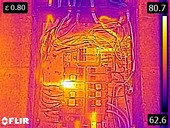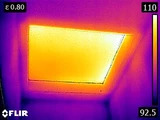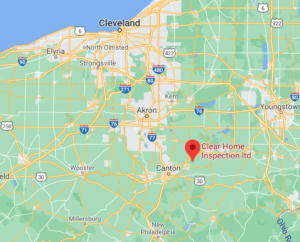Why Infrared Is Crucial To A Home Inspection
Home inspection is a process of examining a home from the outside in, making sure that the home is safe and working the way that it should. One thing, however that an inspector needs help with is seeing inside the home. Not indoors, but inside.
How Does Infrared Make a Difference?
Infrared is a crucial component of a home inspection, and without it is hard to be sure that your home inspector isn’t missing something big.
Think of infrared technology like a flashlight. A flashlight is essential to a home inspection, and there isn’t a single inspector that would show up to an inspection without one. There is no way to see inside of dark areas without a flashlight.
The same can be said for infrared technology, like a flashlight an infrared camera helps us get a picture of what is going on in the inner workings of the home, where it is otherwise impossible to see without damaging the home.
How Does That Help?
The ability to take a thermal image of the home allows inspectors to see what is otherwise next to invisible.
Here are just some of things IR can illuminate for a home inspector.
 .
.  .
.  .
. 
-
Moisture Intrusion
-
Overloaded Wiring
-
Energy Efficiency
-
Plumbing leaks
-
Missing Insulation
-
Air Sealing Issues
-
Window & Door Issues
-
Pests
-
HVAC Performance
-
Appliance Performance
Mold loves moisture, and moisture can be easily found with the help of a thermal scan. Often small leaks go unnoticed, the water damage gradually gets worse. Over time, wood rot and mold can develop.
Pests can be more easily discovered as well – such as an animal sleeping in your attic or wall, termites, bees and infrared can help find the water that carpenter ants love so much.
These defects can negatively impact the health of a homeowner in a lot of ways, and can be serious depending on the severity and how long the defects go unnoticed while someone is living there.
Home buyers rely on home inspections to protect them from this and they count on their Realtor to direct them to only the best Home Inspectors.
Training Is A Must
Just like any high-tech tool, An IR camera in untrained hands can equal big problems. Unfortunately Thermal Imaging is not as intuitive to understand as one might think.
Some building materials have a high thermal reflectivity which can play tricks on an IR camera. Not only will the camera not be able to accurately detect their temperature, but they can cause ghosting or reflections of the infrared light from objects around them.
Here’s just a few pitfalls that await an uninformed Infrared user.
-
Thermal Dynamics
-
It is necessary to have a grasp of the physics behind energy transfer. It will help you to determine exactly what a thermal anomaly is being caused by.
-
-
Emissivity & Thermal Reflectivity
-
Emissivity is the rating of how well a material Radiates Infrared Energy. Thermal Reflectivity describes how well a material Reflects Infrared Energy. Understanding the Inverse Nature of Thermal Reflectivity & Emissivity and how each building material is rated respectively is imperative to understanding an infrared image.
-
-
Atmospheric Conditions
-
Atmospheric conditions can have a big impact on the quality of your IR images. A high relative humidity can diminish or even eliminate the evaporative cooling effect of water. This can impair the effectiveness of an IR Camera at detecting moisture.
-
-
Solar Loading
-
After a long sunny afternoon the sun can effectively wash out any thermal information on a portion of a building. So it is important to know when it is best to scan when and when you should not rely on the images.
-
-
Construction Knowledge
-
Infrared Cameras do not find defects. They can only find Thermal Anomalies, The inspector holding the camera must determine if a thermal anomaly is a building defect. The Home Inspector must have a detailed understanding of how the building they are inspecting is constructed so in turn will know what should be expected when taking thermal images.
-
So it is important to work with a home inspector who is an expert on home construction and has been professionally trained and carries a certification for working with IR such as Certified Residential Thermorapher (CRT) through Monroe Infrared Technology or a similar certification.
Equipment
Not all Infrared Cameras are up to the task of inspecting a home. Having the right one is crucial to how accurate your findings will be. Even with the right training if your camera can’t see it then you can’t see it.
-
Cameras that are cheaper, attach to a cell phone, or are small enough to fit in your pocket are skimping out on important specs and are simply not adequate for use during a home inspection.
-
High thermal resolution & sensitivity are the two most important things that an infrared camera needs to have, because they are what can pick up the smallest details – which can indicate serious, costly defects.
-
The right camara is a significant investment however it will show a detailed, accurate picture of slight temperature differences in the surfaces of a home. This with the know how to interpret the image coupled with the experience to understand what it means can make the difference between finding a defect or missing it. And a defect missed can reflect poorly on everybody who helped a buyer purchase their home.
Things You Should Know About Infrared Technology
-
IR Cannot see through walls like an X-Ray, in fact it cannot even see through a piece of paper. Although there are some materials that are Thermally Transmissive enough to allow infrared waves to pass through them. (a plastic bag is one such material). Most building materials are not Thermally Transmissive.
-
IR cannot see water in or on a wall/surface.
-
The reason IR helps us detect water intrusion is because of the Evaporative Cooling Effect of water. Any wet area will be cooler than the dry areas of the same surface. It will stick out like a sore thumb in a thermal image. It then must be verified as wet with a moisture meter.
-
Where this is most useful is ceilings & walls It is not practical for home inspectors to run a moisture meter across every inch of every ceiling & wall. A thermal scan however will quickly show colder areas that may be wet and should be investigated further.
-
-
IR cannot see mold. It can just see the temperature of the surface of mold. Which can be exactly the same as the surface it is growing on.
-
IR Can however aid us in discovering a water intrusion issue that may cause mold.
-
-
A few notes about IR and Pests. IR can be very useful for pest detection but is not without limitations
-
IR cannot directly detect Wood Destroying Insects. Many wood destroying insects are cold blooded and so will in general be the same temperature as the surrounding environment. However many WDIs will not infest a dry home. So detecting a water issue will tell us where to look closer for wood destroying pests.
-
Bee Hives can certainly produce enough heat to be detectable.
-
Large animals such as s racoon sleeping below the insulation in an attic will transfer enough heat to the ceiling to be detectable
-
Mice in attic insulation may not transfer enough heat to be detectable. So an IR is somewhat unreliable for this
-
Infrared technology is a revolutionary aspect of home inspections, Although IR Cameras cannot actually see through walls they can show us a wealth of information that makes it clear to an IR certified home inspector what is going on below the surface.
Arthur Duhaime CPI, RMS, CRT
Ohio License #2019005236





Leave a Reply
Want to join the discussion?Feel free to contribute!